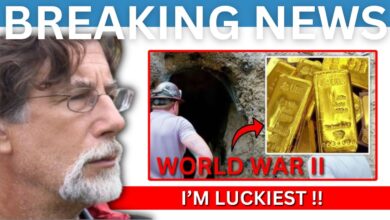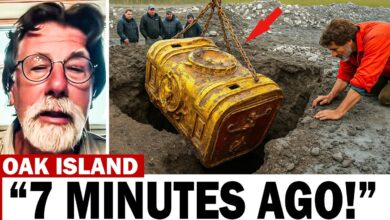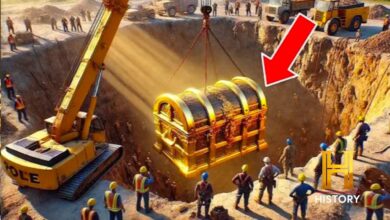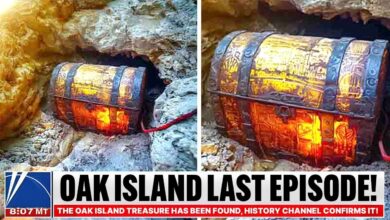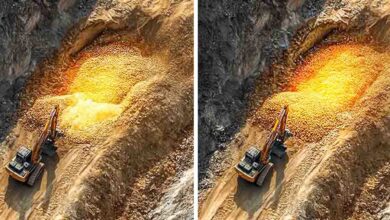Rick Lagina Revealed SHOCKING Discovery Deep Inside Lot 21!
Rick Lagina Revealed SHOCKING Discovery Deep Inside Lot 21!

With features similar to that of The Money Pit, Rick and his team came across this area while digging through the circular depression marked with stones by the lot’s original owner, Robert Young, who thought the circular feature had a bit of importance to it.
Digging to expose the top of the rock feature, Fiona made an unusual discovery; she found broken pieces of red earthenware stuck into the ground.
It was different from the ones they had previously found; on top of that, it had a purple glaze on the rim and a dark glaze on the interior.
Upon further observation, the crew found it to be as ancient as the 1600s because of its utilitarian features.
“If there’s a piece of pottery you don’t recognize, it’s likely to be older, right?”
“Exactly,” Laird confessed to not having come in contact with such an ancient ceramic artifact throughout his career.
Redware, alongside its other uses, was pottery used to transport goods and materials in Europe and North America during the 17th and 18th centuries.
The discovery of the redware was a clue that, despite Lot 5 being abandoned for decades, there was a well.
From the constant beeping, it seemed the circular feature had a lot of iron concentration.
Despite being buried too deep in the ground, it looked like the only way to reach the iron artifacts was through continuous digging.
A year back, a huge metal presence was detected in the circular feature.
Deciding to investigate the metal hit from the previous year, they dug through the soil and found metal covered in hardened clay.
When dusted, the object resembled a metal latch for a cellar or a trapdoor.
It did not seem like a coincidence for ceramic wares and a latch to be found in the same area.
By speculation, the circular area was not formed by natural causes but was a deliberate construction made by people—maybe even the original depositors of the buried treasure.
It was as if the circular depression was built to hide something away from other people’s suspicion.
To get more information on the artifact, it was taken to the investigative center, and according to a report from Emma, after conducting a CT scan, the image presented was much clearer.
At first, the team thought it to be a door knocker or created to be driven into somewhere it unlocks.
According to Laird, his observations pointed to the artifact being a river raft spike with a high quantity of iron, which could have been used for multiple purposes.
“The only thing I found is that it was a river raft spike,” he stated.
Additionally, its origin definitely dates back to the pre-1840s, and when compared with other iron artifacts found on the island and from Sir William Fip’s treasure collectors, it was not similar to the artifact from the island.
However, it did match directly with the William Fips artifacts obtained from Frank White, an Oak Island story follower and collector of artifacts from William Fips’ site.
When taken to a blacksmithing expert, Carmen found it to be a sort of wedge about 4 inches long, with a ring around it.
Carmen also stated that the iron’s thickness indicated it was quite old, and from the image of the CT scan conducted by Emma, he stated that the tool was not used repeatedly, as compared to those which were and had mushroom heads as proof of how often they had been used.
On top of that, it was used like other wedges, and for this reason, it was likely to be driven into wood or rocks.
However, based on the activities that occurred on the island, it was used on wood to bind logs together—maybe as a stopper for horses or as a fastener for carts.
According to Carmen, it also most likely was used for directing heavy cargo underground.
A moment that the team had been waiting for: the Dumac crew completed their construction of the shaft and put it inside the tunnel before they proceeded to climb down the garden shaft.
“What are we going to do? Explain to us what we’re going to do.”
“So, uh, we got to excavate a little bit more; we got to chip some of that clay, and then we can put another set in, okay?”
The chance to explore the garden shaft was a highly anticipated one, most likely since the team started searching for the treasure.
Getting to do it now makes all the hard work worth it.
About 87 feet into the tunnel, brothers Rick and Marty Lagina, alongside Roger Foran from Duma Contracting, encountered an unending shower of water that came from the soil in the tunnel.
The infiltration of water looked like it was coming from the right wall of the tunnel at 60 feet and below.
To stop the leakage, Roger planned to make about nine holes in the wall and put some urethane in it.
In their expertise, this process is very similar to grouting and should be effective in stopping the flow.
The urethane would be sprayed under pressure, and its drying would seal the holes that caused flooding in the tunnel, which was still undergoing construction.
Digging the holes to drain the water had brought the team closer to the tunnel that ran directly under the garden shaft and toward the baby blob.
Despite not being at its full length, the three were at a level that had never been explored by researchers, and getting to their target area was seemingly just beyond arm’s reach.
Aside from the never truly forgotten treasure being out of reach, another goal that the team had achieved was the construction of the horizontal shaft.
The team also had ready reports on the precious materials tested in the waters of The Money Pit area.
A meeting was set up in the war room with geoscientist Dr. Ian Spooner, chemist Dr. Matt Lukan, and hydrogeologist Dr. Fred Michael.
According to Dr. Lukan, fluorescence testing was conducted on the water for evidence of metal and non-metal traces in the water.
Fluorescent spectroscopy was used among the multiple boreholes dug in The Money Pit area.
With this method of testing, L16 had a different result.
According to Ian, the borehole, when dug deep enough, opened into a large void that is known to the team as Aladdin’s Cave.
“Aladdin’s Cave, as you deemed it last year, so what do we hope to see once we get to the bottom of the hole?”
“Treasure chest, deons. We want to know whether this cave is natural or whether it’s been influenced by people.
Yeah, secondarily to that, we’d like to see a way in and a way out.”
The borehole was also stated to have a very high quality of gold in the presence of organic materials, indicating that there was a wooden structure, possibly a tunnel, inside it.
However, at that depth, the chances of finding wood were close to none.
At this point in the expedition, everyone was looking forward to sonar examination, which promised to shed more light on what had been discovered.
The discovery of ancient coins still within Lot 5’s surrounding area led Rick and Gary to go on an investigative operation to check out the flagged spots and detect a metallic target.
One of them used the metal detector machine while the other dug through and pulled out a portion of the soil in the marked area.
Soon, the metal detector device alerted signs of heavy and solid metal close to the Earth’s surface.
After careful digging, they soon came across something and found it to be an ancient coin.
This was a good sign as they searched for the treasure.
It was indeed a good start, as the texture and quality of the coin seemed to be similar to those of the ancient Roman coin found within a few feet of the current spot several years ago.
But that was not the only good sign; it seemed the coin was handmade, specifically hammered.
Soon after the first coin discovery, another was made a few feet away at a flat spot.
This time around, the discovery was much easier, and like the first coin, this one was also hand-hammered.
This discovery cheered up the team and gave them the motivation to continue digging for clues.
Rick was quick to call his brother Marty to come down to the area to share in the excitement and also help in the search.
After several trials, Rick made another discovery, adding the third coin to the collection found on Lot 5.
This coin also had a similarity with the two previously found; upon deeper examination, they realized that the patina looked the same.
It was definitely hand-hammered and dated further than the discovery of Oak Island.
“That is fantastic! Look at that!”
“I thought I saw something; that’s a coin, and another hand-hammered one!”
At this point, the crew believed that the coins were definitely clues to the big picture of what happened on Lot 5.
Taking their findings to Laird and Emma at the interpretive center, the coins were analyzed using the XRF and CT scan, and after a few minutes, the results came back.
The first coin was analyzed to have about 94% copper and about 5% silver, which was different from the properties of Roman coins, which were tin and lead.
This analysis indicated that the first coin was not originally from Rome, but it was still very ancient and had no features or properties of modern coins.
Meanwhile, the second coin seemed to be made from a different metal; after undergoing the XRF, its properties were discovered.
The coin was made up of copper, silicon, lead, and tin—a definite match to the ancient Roman coins found in one of their previous expeditions and most likely was brought to the island by the Knights Templar or the original treasure deposit




